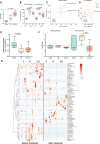Aging: a possible road toward gut microbiota pathoadaptation
- PMID: 40770832
- PMCID: PMC12332998
- DOI: 10.1080/19490976.2025.2542375
Aging: a possible road toward gut microbiota pathoadaptation
Abstract
Laboratory-raised mice live approximately seven times longer and healthier lives compared to their wild counterparts, due to a standardized healthy diet and limited exposure to environmental stressors. Aging is associated with increased inflammation and microbial dysbiosis. Collectively, these influence microbiota evolution and may contribute to the enrichment in pathobiont frequency observed in old age. Alternatively, this increase could stem from a decline in colonization resistance, creating favorable conditions for pathobiont invasion. Here, we sought to test whether aging in healthy, controlled conditions, could prevent the selection of age-associated pathobionts. We have followed the adaptive evolution of a commensal strain of Escherichia coli in the guts of mice of advanced age and found that it acquired several mutations common to bacteria colonizing young mice, which were absent in old animals. This, together with the increase in Akkermansia muciniphila in mice of advanced age, suggest healthy aging. However, mutations acquired exclusively in the older were mainly pathoadaptive, tuning the metabolism to oxygen and iron availability, hypermotility, and biofilm formation.
Keywords: Aging; Escherichia coli; experimental evolution; microbiota; pathoadaptation.
Conflict of interest statement
No potential conflict of interest was reported by the author(s).
Figures





References
-
- Santos-Pujol E, Noguera-Castells A, Casado-Pelaez M, García-Prieto CA, Vasallo C, Campillo-Marcos I, Quero-Dotor C, Crespo-García E, Bueno-Costa A. The multiomics blueprint of extreme human lifespan. 2025.
MeSH terms
Supplementary concepts
LinkOut - more resources
Full Text Sources
Medical
